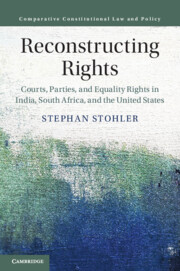 Reconstructing Rights
Reconstructing Rights Book contents
- Frontmatter
- Dedication
- Contents
- List of Figures
- List of Tables
- Acknowledgements
- Abbreviations
- Part I Introduction
- Part II United States of America
- 2 Equality Rights in American Education and Public Spending
- 3 Equality Rights in American Employment
- 4 Equality Rights in American Representation
- Part III India
- Part IV South Africa
- Part V conclusion
- Bibliography
- Index
- Series
4 - Equality Rights in American Representation
from Part II - United States of America
Published online by Cambridge University Press: 09 July 2019
- Frontmatter
- Dedication
- Contents
- List of Figures
- List of Tables
- Acknowledgements
- Abbreviations
- Part I Introduction
- Part II United States of America
- 2 Equality Rights in American Education and Public Spending
- 3 Equality Rights in American Employment
- 4 Equality Rights in American Representation
- Part III India
- Part IV South Africa
- Part V conclusion
- Bibliography
- Index
- Series
Summary
Shortly after the adoption of the Voting Rights Act of 1965, progressive reformers recognized new threats to minority representation that went beyond minority disenfranchisement and included efforts to dilute minority representation. Progressive justices aligned with the Democratic Party helped to refashion election law to address these evolving shortcomings by reinterpreting the statute as well as the Fourteenth and Fifteenth Amendments. Conservative justices countered by proposing new, restrictive doctrinal positions. But when those positions deviated from the wishes of elected Republicans, they capitulated and instead developed a new right discouraging racial gerrymandering. The pattern of evolving doctrinal positions is best described by the deliberative partnership thesis.
Keywords
- Type
- Chapter
- Information
- Reconstructing RightsCourts, Parties, and Equality Rights in India, South Africa, and the United States, pp. 101 - 130Publisher: Cambridge University PressPrint publication year: 2019
